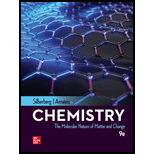
Concept explainers
(a)
Interpretation:
The strongest intermolecular force between solute and solvent in the solution of copper in silver is to be determined.
Concept introduction:
The solution is a homogenous mixture that is formed from two or more substances. It consists of two components, solute, and solvent. The substance that is present in a smaller amount and is dissolved in the other substance is called solute. The solvent is that substance which is present in a larger amount and it dissolves solute in itself.
The intermolecular forces are the forces that act between molecules, atoms or ions. They are relatively weak forces of attraction. These are of five types as hydrogen bonding, ionic bonding, ion-dipole forces, ion-induced dipole forces, van der Waals forces.
(b)
Interpretation:
The strongest intermolecular force between solute and solvent in the solution of chloromethane in dimethyl ether is to be determined.
Concept introduction:
The solution is a homogenous mixture that is formed from two or more substances. It consists of two components, solute, and solvent. The substance that is present in a smaller amount and is dissolved in the other substance is called solute. The solvent is that substance which is present in a larger amount and it dissolves solute in itself.
The intermolecular forces are the forces that act between molecules, atoms or ions. They are relatively weak forces of attraction. These are of five types as hydrogen bonding, ionic bonding, ion-dipole forces, ion-induced dipole forces, van der Waals forces.
(c)
Interpretation:
The strongest intermolecular force between solute and solvent in the solution of ethane in propylamine is to be determined.
Concept introduction:
The solution is a homogenous mixture that is formed from two or more substances. It consists of two components, solute, and solvent. The substance that is present in a smaller amount and is dissolved in the other substance is called solute. The solvent is that substance which is present in a larger amount and it dissolves solute in itself.
The intermolecular forces are the forces that act between molecules, atoms or ions. They are relatively weak forces of attraction. These are of five types as hydrogen bonding, ionic bonding, ion-dipole forces, ion-induced dipole forces, van der Waals forces.
Want to see the full answer?
Check out a sample textbook solution
Chapter 13 Solutions
CHEMISTRY:MOLECULAR...(LL)-W/CONNECT
- please provide the structure for this problem, thank youarrow_forwardpresented by Morallen Lig Intermine the hand product for the given mution by adding atoms, bonds, nonhonding diarion panda скуль Step 3: Comp the draw the product Step 2: Agama workup Compithe 429 ملولةarrow_forwardReaction A 0,0arrow_forward
- presented by Morillon Leaning Predict the organic product for the min кусур HSC Adithane carved arnown to come than that to the condon slchroruis in acid in in aquishri with ноюarrow_forward6.15PM Sun Mar 30 K Draw the major product of this reaction. Include any relevant stereochemistry. Ignore inorganic byproducts. Problem 1 of O H [PhзPCH2CH3]*C|¯ NaH Drawing > Q Atoms, Bonds and Draw or tap a nearrow_forward8:17 PM Sun Mar 30 Draw the major product of this reaction. Ignore inorganic byproducts. HSCH2CH2CH2SH, BF3 Probler Drawing Ato Bonds Clarrow_forward
- Name the major organic product of the following action of 4-chloro-4-methyl-1-pentanol in neutral pollution 10+ Now the product. The product has a molecular formula f b. In a singly hain, the starting, material again converts into a secule with the molecular kormula CIO. but with comply Draw the major organic structure inhalationarrow_forwardMacmillan Learning Alcohols can be oxidized by chromic acid derivatives. One such reagent is pyridinium chlorochromate, (C,H,NH*)(CICTO3), commonly known as PCC. Draw the proposed (neutral) intermediate and the organic product in the oxidation of 1-butanol by PCC when carried out in an anhydrous solvent such as CH₂C₁₂. PCC Intermediate OH CH2Cl2 Draw the intermediate. Select Draw Templates More с H Cr о Product Draw the product. Erase Select Draw Templates More H о Erasearrow_forwardIf I have 1-bromopropene, to obtain compound A, I have to add NaOH and another compound. Indicate which compound that would be. A C6H5 CH3arrow_forward
 ChemistryChemistryISBN:9781305957404Author:Steven S. Zumdahl, Susan A. Zumdahl, Donald J. DeCostePublisher:Cengage Learning
ChemistryChemistryISBN:9781305957404Author:Steven S. Zumdahl, Susan A. Zumdahl, Donald J. DeCostePublisher:Cengage Learning ChemistryChemistryISBN:9781259911156Author:Raymond Chang Dr., Jason Overby ProfessorPublisher:McGraw-Hill Education
ChemistryChemistryISBN:9781259911156Author:Raymond Chang Dr., Jason Overby ProfessorPublisher:McGraw-Hill Education Principles of Instrumental AnalysisChemistryISBN:9781305577213Author:Douglas A. Skoog, F. James Holler, Stanley R. CrouchPublisher:Cengage Learning
Principles of Instrumental AnalysisChemistryISBN:9781305577213Author:Douglas A. Skoog, F. James Holler, Stanley R. CrouchPublisher:Cengage Learning Organic ChemistryChemistryISBN:9780078021558Author:Janice Gorzynski Smith Dr.Publisher:McGraw-Hill Education
Organic ChemistryChemistryISBN:9780078021558Author:Janice Gorzynski Smith Dr.Publisher:McGraw-Hill Education Chemistry: Principles and ReactionsChemistryISBN:9781305079373Author:William L. Masterton, Cecile N. HurleyPublisher:Cengage Learning
Chemistry: Principles and ReactionsChemistryISBN:9781305079373Author:William L. Masterton, Cecile N. HurleyPublisher:Cengage Learning Elementary Principles of Chemical Processes, Bind...ChemistryISBN:9781118431221Author:Richard M. Felder, Ronald W. Rousseau, Lisa G. BullardPublisher:WILEY
Elementary Principles of Chemical Processes, Bind...ChemistryISBN:9781118431221Author:Richard M. Felder, Ronald W. Rousseau, Lisa G. BullardPublisher:WILEY





